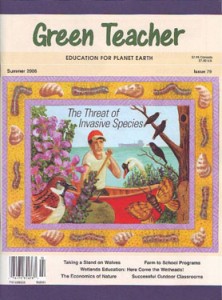Green Teacher 79, Summer 2006
Purchase this issue or subscribe
Features
Exotic Invasive Species: The Guests That Won’t Go Home by Kim Cleary Sadler
In the continental United States, approximately 6-8 percent of species are introduced exotics. In Canada, exotic species account for about 5 percent of mammal species and 27 percent of vascular plants. Many are not harmful, but those that are pose a serious threat to biodiversity on this continent. Kim Cleary Sadler examines the problem, looks closely at examples of exotic pest invasions such as purple loosestrife, zebra mussels, exotic tree fungi and non-native birds, and explains why educators should address this critical topic.
A Date with Freddie Kudza
In this highly interactive physical activity, students learn about the characteristics of invasive exotic pest plants by becoming exotic pests themselves!
Adapted with permission from “Noxious Neighbours: Exotics in Our Backyard,” Centre for Environmental Education, Middle Tennessee State University
Something’s Choking Auntie Elm
In this activity, students learn about several exotic species in North America and gather information to determine their impact on the environment
Adapted with permission from “Noxious Neighbours: Exotics in Our Backyard,” Centre for Environmental Education, Middle Tennessee State University
Sun Block
In this active game, students emulate the transfer of food energy in a lake habitat in order to compare a healthy habitat and one disrupted by an invasive plant species
Adapted with permission from “Making Waves! Protecting Ontario’s Aquatic Habitats from Invading Species”
Kids Teaching Kids: The Tantramar Wetlands Centre Project by Chris Porter
Known as the “Wetheads,” a group of New Brunswick high school students are delivering wetland education programs to 4,000 schoolchildren annually at the school’s restored wetland
Sunnyside and the Wolf by Steven Siegal
Testifying at public hearings on contentious issues is an opportunity for students to gain first-hand experience in participatory democracy and an understanding of their role as citizens
Valuing Nature in Environmental Education by Nicholas Bayard
Activities for introducing concepts of environmental economics, for grades 5-6
Georgia’s Outdoor Classroom Symposium by Karen Garland
How Georgia educators have developed the most successful outdoor classroom movement on the continent
The Field of Dreams (and Other Outdoor Classroom Myths) by Karen Wood
It takes more than benches and butterfly bushes to create a well-used outdoor classroom. Here’s how one school is succeeding through creative ideas that give teachers the training, tools, and confidence to take learning outdoors.
Sustaining Outdoor Classrooms by Amanda Kail
How to keep outdoor classrooms from becoming a forgotten and abandoned bed of weeds
And as always, over 20 new educational resources are profiled and evaluated in this issue of Green Teacher.
Leave a Reply
You must be logged in to post a comment.






